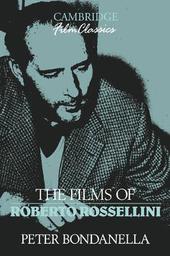
|
The Films of Roberto Rossellini
Hardback
Main Details
| Title |
The Films of Roberto Rossellini
|
| Authors and Contributors |
By (author) Peter Bondanella
|
| Series | Cambridge Film Classics |
|---|
| Physical Properties |
| Format:Hardback | | Pages:200 | | Dimensions(mm): Height 237,Width 161 |
|
| Category/Genre | Films and cinema |
|---|
| ISBN/Barcode |
9780521392365
|
| Classifications | Dewey:791.43092 |
|---|
| Audience | | Tertiary Education (US: College) | | General | | Professional & Vocational | |
|---|
| Illustrations |
51 Halftones, unspecified
|
|
Publishing Details |
| Publisher |
Cambridge University Press
|
| Imprint |
Cambridge University Press
|
| Publication Date |
29 January 1993 |
| Publication Country |
United Kingdom
|
Description
The Films of Roberto Rossellini traces the career of one of the most influential Italian filmmakers through close analysis of the seven films that mark important turning points in his evolution: The Man with a Cross (1943), Open City (1945), Paisan (1946), The Machine to Kill Bad People (1948-52), Voyage in Italy (1953), General della Rovere(1959), and The Rise to Power of Louis XIV (1966). Beginning with Rossellini's work within the fascist cinema, it discusses his invention of neorealism, a new cinematic style that resulted in several classics during the immediate postwar period. Almost immediately, however, Rossellini's continually evolving style moved beyond mere social realism to reveal other aspects of the camera's gaze, as is apparent in the films he made with Ingrid Bergman during the 1950s; though unpopular, these works had a tremendous impact on the French New Wave critics and directors. Rossellini's late career marks a return to his nonrealist period, now critically reexamined, in such works as the commercially successful General della Rovere, and his eventual turn to the creation of didactic films for television.
Reviews"Bondanella's excellent addition to the 'Cambridge Film Classics' series provides an overview of the work of the originator of Italian neorealism...There is a real depth to Bondanella's analysis of Rossellini's ideology and to his discussion of innvovations in cinematic technique such as the 'Pancinor zoom.' Chronology, filmology, and bibliography as well as invaluable notes. An excellent introduction to Rossellini for undergraduate students of film, and the more advanced student or scholar should also benefit from the current bibliography and from some of the insightful analyses." Choice
|